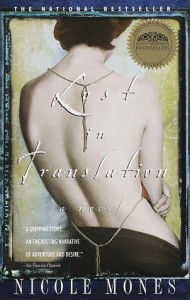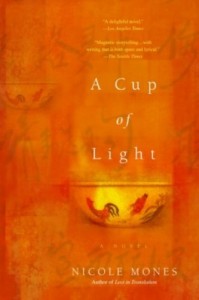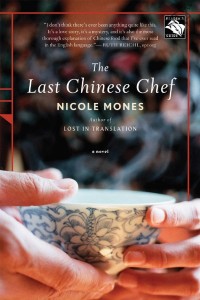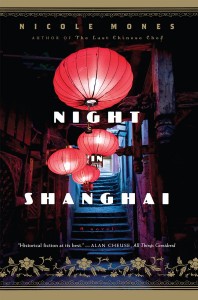The novels of Nicole Mones
Overheard in the bookstore the other day:
“Have you read this? It’s wonderful.”
“I don’t read novels, when I read I want to learn and educate myself.”
I’ve heard variations on this opinion before from smart and respectable non-fiction-only readers and I always nod and smile. In truth, however, I have to quell the urge to grab them by the arm, march them into a comfortable chair, give them a cup of coffee and demand they read an author such as Nicole Mones.
A newly launched textile business took Nicole Mones to China for the first time in 1977, after the end of the Cultural Revolution. She traded textiles with China for eighteen years before she turned to writing. Ms. Mones’ extensive knowledge of China’s culture, history and politics is woven throughout her books. Her novels are enthralling, but each one is an education as well. Ms. Mones is an author who obviously understands that there are readers who want to think and be entertained at the same time.
++++++++++++++++++
 Lost In Translation, Ms. Mones’ debut novel takes the reader into the world of Alice, an unlikeable American woman living in contemporary China. Alienated from her Congressman father because of his overt racism, Alice seeks to leave America behind and become Chinese. She works as a translator by day and secretly haunts bars at night often having one night stands with Chinese men – trying to understand and connect with the xenophobic culture.
Lost In Translation, Ms. Mones’ debut novel takes the reader into the world of Alice, an unlikeable American woman living in contemporary China. Alienated from her Congressman father because of his overt racism, Alice seeks to leave America behind and become Chinese. She works as a translator by day and secretly haunts bars at night often having one night stands with Chinese men – trying to understand and connect with the xenophobic culture.
But things change for Alice when she accepts a translator position with an archeological team tracking the remains of the ancient and important Chinese treasure — “the Peking Man”. Alice becomes close to Lin a member of the team, while they navigate mysterious secret meetings and the threat of arrest. Working with Lin, she forms a close connection and better understanding of Chinese culture and history
The novel not only mesmerizes with the fictional characters and storyline, but goes further to weave in the historical significance of Peking Man as the first ancestor of China and the important writings of the French Jesuit priest-philosopher, Tielhard de Chardin, from whom the archeological team gains clues as to the whereabouts of the bones. This novel has it all – an engrossing mystery combined with Chinese cultural history and a dash of sex and romance.
The title* captures the gist of the novel, namely the difficulties of trying to move between cultures, language, history and current society — never being sure what has been lost in translation. (*No relation to the Bill Murray film of the same name.)
+++++++++++++++++++++++
 A Cup of Light transports us into the rarefied world of Chinese porcelain “pots” long treasured by emperors and collectors alike.
A Cup of Light transports us into the rarefied world of Chinese porcelain “pots” long treasured by emperors and collectors alike.
Lia Frank is an American appraiser of fine Chinese porcelain and is sent to Beijing to authenticate a collection of rare pots going up for international sale. As she unpacks the crates, holding each delicate piece and “feeling” the refined porcelain, she discovers there are many more pots than originally estimated and that some of them are “fakes”. But these are no ordinary fakes –these are forgeries so exquisite, so precise that she has to find the forger. In Chinese culture when the copy is as beautiful as the piece it imitates then the forgery and the forger are greatly admired.
Again an education here — with A Cup of Light you’ll discover the infamous Chenghua Chinese cups, visit the town of Jingdezhen where the truly priceless pots were manufactured for the emperors and learn how these pots were hidden and smuggled out (with some lost) during the 1931 Japanese invasion. Also, if you’re like me you’ll cringe in embarrassment as you learn that J.P. Morgan (yes that J.P. Morgan) tried to buy the entire contents of the Forbidden City in 1913 for twenty million dollars – so many of the priceless and culturally important pots were buried and hidden. Luckily, old J.P. died and the deal was abandoned.
Lia wears hearing aids and takes them out to achieve complete silence to exercise her memories. Lia is a mnemonist and has memorized not only every pot she has ever examined, but also every catalog and history. She uses the Greek/Roman mnemonic system to memorize and at first I found it unbelievable, but with a little research I found it was actually a real thing. Ms. Mones also based this on the real missionary Matteo Ricci who taught young Chinese scholars tricks to increase their memory skills–an important advantage in a nation with countless laws and rituals which had to be learned by heart. But I digress, when Lia goes into her memory files to help her determine which pot is real or fake, we get some fascinating Chinese porcelain history. Also fascinating is the current day political intrigue intruding into Lia’s world of beautiful pots contrasted with her researching (remembering) similar shadiness throughout the history of Chinese porcelain.
Ms. Mones was a textile trader in China for many years and her knowledge of the underworld of art smuggling and forgeries shines through. In each of her novels, the lead female characters have many flaws, but Ms. Mones always portrays them as competent, professional women with real work to accomplish.
+++++++++++++++++++++++
 The Last Chinese Chef is probably my favorite of her novels. This time, Ms. Mones, a contributor to the now sadly defunct Gourmet magazine, takes us into the luscious world of Chinese cuisine.
The Last Chinese Chef is probably my favorite of her novels. This time, Ms. Mones, a contributor to the now sadly defunct Gourmet magazine, takes us into the luscious world of Chinese cuisine.
When Maggie McElroy, a widowed American food writer, learns of a Chinese paternity claim against her late husband’s estate, she has to go immediately to Beijing. She asks her magazine for time off, but her editor counters with an assignment: to profile the rising culinary star, Sam Liang, who is about to open an imperial-style restaurant in Beijing. When the restaurant opening is delayed Sam, who is half Chinese, half American, acts as Maggie’s translator and helps her track down the child and unravel the mystery of the parentage.
But readers – it’s the backdrop of the FOOD that is the heart and soul of this novel.
We understand the intricacies of Chinese cuisine. The concepts of texture and appearance are as important as flavor on the Chinese table. We learn about “guanxi” — the Chinese concept of relationships. We see that food is at the heart of Chinese relationships, one reason why all meals are shared in China and never individually plated. Chinese cuisine is very much about presentation including symbols and references which are understood instantly and connect its people not only to one another but to their culture and history.
This is not to say that the characters or the plot of The Last Chinese Chef aren’t compelling — oh they are. Sam, the heir to the family’s cooking expertise, is sexy yet gentle – helping Maggie comprehend the often mystifying Chinese culture and re-awakens her interest in food by preparing her luscious dishes (I know… sigh). Sam decides to enter a Chinese cooking competition and we watch, smell and taste the tapestry of the food he prepares to practice. Sam’s grandfather, Liang Wei, had been one of the last generation of chefs in the Forbidden City and the author of a highly regarded tome on the art of Chinese cuisine. Each chapter of the book starts with quotes of wisdom from this fictional but very realistic Chinese cook book. Eventually, Maggie and Sam unravel the truth behind the child’s parentage, but by then Maggie doesn’t care so much, re-awakened from her grief and happily eating.
+++++++++++++++++++++++
 Night in Shanghai is Ms. Mone’s most recent novel. I haven’t read it, but it’s next on my list.
Night in Shanghai is Ms. Mone’s most recent novel. I haven’t read it, but it’s next on my list.
It’s about the little-known story of black musicians in the Chinese jazz age. You can watch the book’s trailer HERE.
(Who knew that one day book publishing/marketing includes film-style trailers.)





